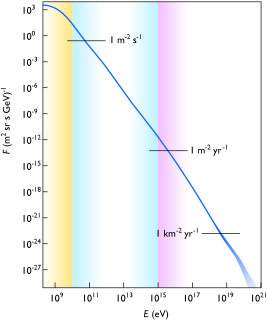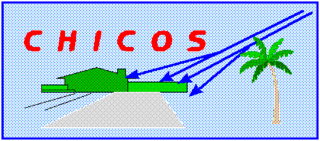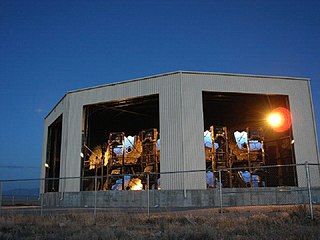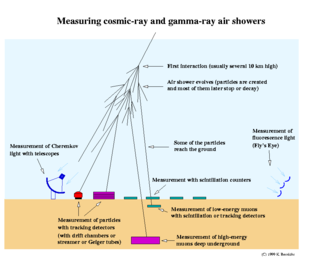Related Research Articles

A Geiger counter is an electronic instrument used for detecting and measuring ionizing radiation. It is widely used in applications such as radiation dosimetry, radiological protection, experimental physics and the nuclear industry.

Cosmic rays are high-energy protons and atomic nuclei that move through space at nearly the speed of light. They originate from the Sun, from outside of the Solar System in our own galaxy, and from distant galaxies. Upon impact with Earth's atmosphere, cosmic rays produce showers of secondary particles, some of which reach the surface, although the bulk is deflected off into space by the magnetosphere or the heliosphere.

Brookhaven National Laboratory (BNL) is a United States Department of Energy national laboratory located in Upton, Long Island, and was formally established in 1947 at the site of Camp Upton, a former U.S. Army base and Japanese internment camp. Its name stems from its location within the Town of Brookhaven, approximately 60 miles east of New York City. It is managed by Stony Brook University and Battelle Memorial Institute.
The Greisen–Zatsepin–Kuzmin limit (GZK limit) is a theoretical upper limit on the energy of cosmic ray protons traveling from other galaxies through the intergalactic medium to our galaxy. The limit is 5×1019 eV (50 EeV), or about 8 joules (the energy of a proton travelling at ≈ 99.99999999999999999998% the speed of light). The limit is set by the slowing effect of interactions of the protons with the microwave background radiation over long distances (≈ 160 million light-years). The limit is at the same order of magnitude as the upper limit for energy at which cosmic rays have experimentally been detected, although indeed some detections appear to have exceeded the limit, as noted below. For example, one extreme-energy cosmic ray, the Oh-My-God Particle, which has been found to possess a record-breaking 3.12×1020 eV (50 joules) of energy (about the same as the kinetic energy of a 95 km/h baseball).

A scintillation counter is an instrument for detecting and measuring ionizing radiation by using the excitation effect of incident radiation on a scintillating material, and detecting the resultant light pulses.

A scintillator is a material that exhibits scintillation, the property of luminescence, when excited by ionizing radiation. Luminescent materials, when struck by an incoming particle, absorb its energy and scintillate. Sometimes, the excited state is metastable, so the relaxation back down from the excited state to lower states is delayed. The process then corresponds to one of two phenomena: delayed fluorescence or phosphorescence. The correspondence depends on the type of transition and hence the wavelength of the emitted optical photon.
In astroparticle physics, an ultra-high-energy cosmic ray (UHECR) is a cosmic ray with an energy greater than 1 EeV (1018 electronvolts, approximately 0.16 joules), far beyond both the rest mass and energies typical of other cosmic ray particles.
In experimental and applied particle physics, nuclear physics, and nuclear engineering, a particle detector, also known as a radiation detector, is a device used to detect, track, and/or identify ionizing particles, such as those produced by nuclear decay, cosmic radiation, or reactions in a particle accelerator. Detectors can measure the particle energy and other attributes such as momentum, spin, charge, particle type, in addition to merely registering the presence of the particle.

Raymond Davis Jr. was an American chemist and physicist. He is best known as the leader of the Homestake experiment in the 1960s-1980s, which was the first experiment to detect neutrinos emitted from the Sun; for this he shared the 2002 Nobel Prize in Physics.

Neutron detection is the effective detection of neutrons entering a well-positioned detector. There are two key aspects to effective neutron detection: hardware and software. Detection hardware refers to the kind of neutron detector used and to the electronics used in the detection setup. Further, the hardware setup also defines key experimental parameters, such as source-detector distance, solid angle and detector shielding. Detection software consists of analysis tools that perform tasks such as graphical analysis to measure the number and energies of neutrons striking the detector.

The Cosmotron was a particle accelerator, specifically a proton synchrotron, at Brookhaven National Laboratory. Its construction was approved by the U.S. Atomic Energy Commission in 1948, reaching its full energy in 1953, and continuing to run until 1966. It was dismantled in 1969.
The National Synchrotron Light Source (NSLS) at Brookhaven National Laboratory (BNL) in Upton, New York was a national user research facility funded by the U.S. Department of Energy (DOE). Built from 1978 through 1984, and officially shut down on September 30, 2014, the NSLS was considered a second-generation synchrotron.

A neutrino detector is a physics apparatus which is designed to study neutrinos. Because neutrinos only weakly interact with other particles of matter, neutrino detectors must be very large to detect a significant number of neutrinos. Neutrino detectors are often built underground, to isolate the detector from cosmic rays and other background radiation. The field of neutrino astronomy is still very much in its infancy – the only confirmed extraterrestrial sources as of 2018 are the Sun and the supernova 1987A in the nearby Large Magellanic Cloud. Another likely source is the blazar TXS 0506+056 about 3.7 billion light years away. Neutrino observatories will "give astronomers fresh eyes with which to study the universe".

The California High School Cosmic Ray Observatory,, operated by the Kellogg Laboratory at the California Institute of Technology in Pasadena, California, United States, is one of the world's largest ongoing Cosmic Ray observatory programs. It is known for its large network within the Los Angeles County area, based mainly on high school sites carrying cosmic ray detector units, though there are also detector units on associated elementary schools and middle schools.
Astroparticle physics, also called particle astrophysics, is a branch of particle physics that studies elementary particles of astronomical origin and their relation to astrophysics and cosmology. It is a relatively new field of research emerging at the intersection of particle physics, astronomy, astrophysics, detector physics, relativity, solid state physics, and cosmology. Partly motivated by the discovery of neutrino oscillation, the field has undergone rapid development, both theoretically and experimentally, since the early 2000s.

The Telescope Array project is an international collaboration involving research and educational institutions in Japan, The United States, Russia, South Korea, and Belgium. The experiment is designed to observe air showers induced by ultra-high-energy cosmic ray using a combination of ground array and air-fluorescence techniques. It is located in the high desert in Millard County, Utah, United States, at about 1,400 meters (4,600 ft) above sea level.

A cosmic-ray observatory is a scientific installation built to detect high-energy-particles coming from space called cosmic rays. This typically includes photons, electrons, protons, and some heavier nuclei, as well as antimatter particles. About 90% of cosmic rays are protons, 9% are alpha particles, and the remaining ~1% are other particles.
The Washington Area Large-scale Time-coincidence Array (WALTA) is a cosmic ray physics experiment run by the University of Washington to investigate ultra high energy cosmic rays (>1019eV). The program uses detectors placed at Seattle-area high schools and colleges which are linked via the internet, effectively forming an Extensive Air Shower array. In addition to working on the unexplained levels of Ultra High Energy cosmic ray (UHECR) flux, it hopes to serve as a pedagogical tool for increasing the physics involvement of high schools and community colleges with a University level physics experiment. Each site has three to four scintillation detectors with the goal of having enough sites to cover a 200 km2 area around the city of Seattle. WALTA is a part of the larger NALTA project which hopes to combine data from several WALTA like projects to further the exploration of UHE cosmic rays.
The NASA Space Radiation Laboratory (NSRL, previously called Booster Applications Facility), is a heavy ion beamline research facility; part of the Collider-Accelerator Department of Brookhaven National Laboratory, located in Upton, New York on Long Island. Its primary mission is to use ion beams (H+to Bi83+) to simulate the cosmic ray radiation fields that are more prominent beyond earth's atmosphere.
Ady Hershcovitch is a plasma physicist best known for his 1995 invention, the plasma window, which was later patented.. In the plasma window, a plasma separates air from a vacuum by preventing the air from rushing into the vacuum. This scientific development can facilitate non-vacuum ion material modification, manufacturing of superalloys, and high-quality non-vacuum electron-beam welding. The device has been compared to the force field in the Star Trek TV series. He is well known for his work in plasma physics at Brookhaven National Laboratory. He has over 80 publications and 15 patents.
References
- ↑ Eraly, Susan; Grossberg, Joshua; Tkaczyk, Marcin. "MARIACHI Experimental Detection of Radio Wave Reflection off a High Energy Ionization Beam" (PDF). Stony Brook University, Department of Electrical and Computer Engineering. Retrieved 5 January 2016.
- ↑ "NSRL Technical Note TN10-001, Beam Characterization Studies at NSRL" (PDF). February 2010. Retrieved 5 January 2016.
- ↑ Takai, Helio (2006-04-26). "MARIACHI — Detecting Ultra High Energy Cosmic Rays with radar". American Physical Society, APS April Meeting, April 22–26, 2006. Bibcode:2006APS..APR.P7009T.
- ↑ Takai, H.; Feldman, C.; Minelli, M.; Sundermier, J.; Winters, G.; Russ, M. K.; Dodaro, J.; Varshney, A.; McIlwaine, C. J.; Tomaszewski, T.; Tomaszewski, J.; Warasila, R.; McDermott, J.; Khan, U.; Chaves, K.; Kassim, O.; Ripka, J. (2016). "Tidal Frequencies in the Time Series Measurements of Atmospheric Muon Flux from Cosmic Rays". arXiv: 1610.05983 [astro-ph.HE].